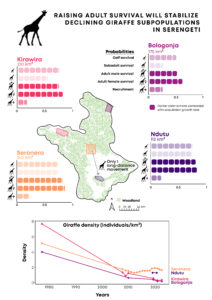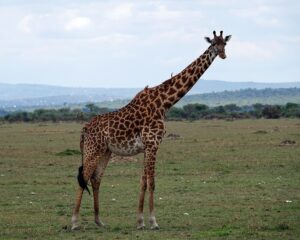The giraffe, one of Africa’s most iconic animals, is facing a crisis. Despite their worldwide popularity, giraffe populations in the wild are declining due to illegal killing and habitat loss. A new study published in the Journal of Wildlife Management reveals that targeted conservation strategies—particularly those focused on adult survival—are essential to reverse these trends in the Serengeti Ecosystem.
Led by scientists from the University of Zurich’s Population Ecology research group and their international partners, the study shows that giraffe numbers in the center of Serengeti’s protected areas have stabilized since the late 2000s, following major declines in previous decades. However, populations near the edges of the protected areas continue to shrink.

“We needed to understand whether protected areas in the Serengeti were effectively conserving giraffes,” said Dr. George Lohay, co-author and Head Scientist at the Grumeti Fund. “Our results clearly show where giraffes are doing well and where urgent action is needed.”
The research team compiled multiple years of photographic data identifying 1,520 individual Masai giraffes across four subpopulations. Using both Bayesian and frequentist modelling approaches, they estimated survival rates, birth rates, population densities, and long-distance movements. Their findings highlight significant differences in adult survival among subpopulations, with lower adult survival rates linked to population declines.
“Adult survival emerged as the strongest demographic driver of giraffe population trends,” said Dr. Dominik Behr, co-lead author and postdoctoral researcher at the University of Zurich. “This means that improving adult survival is key if we want to prevent further declines.”
The study also found extremely limited movement between subpopulations—only one giraffe was observed crossing between them. This suggests strong subpopulation insularity and limited gene flow, which may increase the risk of local extinction due to low genetic diversity.
“Giraffes have unique coat patterns, which we use to identify individuals from photographs,” explained Dr. Monica Bond, co-lead author from the University of Zurich and Wild Nature Institute. “We combined all available giraffe images—taken during road surveys and from camera traps—to track individual fates and estimate demographic trends over time.”
Earlier studies in the 1970s and 2000s had documented dramatic population declines, but recent changes in land use and tourism warranted an updated analysis. The new data show that while central and southern subpopulations in the center of the protected areas are now stable, western and northeastern subpopulations along the borders of the protected areas continue to decline—highlighting the need for subpopulation-specific conservation action.
“The best way to conserve giraffes and other large mammals is by protecting large areas of intact habitat,” said Dr Lohay. “Community conservation efforts have successfully raised adult survival in other parts of Tanzania. Scaling up these initiatives around the Serengeti could make a critical difference.”
“Our work shows how long-term demographic monitoring can guide conservation priorities in complex ecosystems,” said Prof. Arpat Ozgul, senior author and ecologist at the University of Zurich. “Targeted efforts that improve adult survival in key areas could determine the fate of these isolated subpopulations.”

The study was conducted by researchers from the University of Zurich, Wild Nature Institute, Pennsylvania State University, Estación Biológica de Doñana, and the Grumeti Fund’s RISE program.
